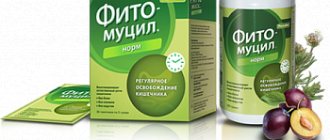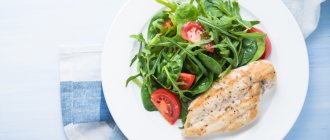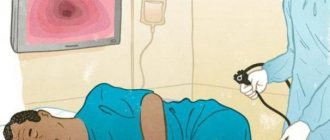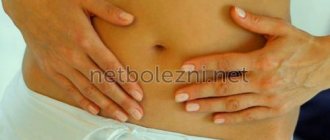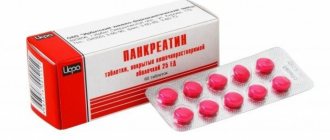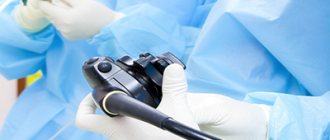Fleet Phospho-Soda
The main thing in preparation is to cleanse the colon of feces. The cleanliness of the intestinal walls affects the quality and accuracy of the data obtained as a result of the examination, and therefore the correctness of the prescribed treatment. Therefore, it is important to prepare the intestines as best as possible. With the new drug Fleet Phospho-Soda, this has become much easier.
How does Fleet Phospho-Soda work?
Fleet Phospho-Soda is the first hyperosmolar solution in Russia designed to prepare the intestines for colonoscopy and surgical interventions. It has many advantages, but in terms of patient comfort, the main one is the reduced volume of fluid that needs to be drunk. Instead of the usual 4 liters, you will have to drink exactly 2 times less: 400 ml (2 glasses) of ginger-lemon solution and another 1.6 liters (6 glasses) of plain water. If we consider that the drug is taken in two doses (in accordance with the preparation regimen), the advantage becomes obvious.
Efficiency of Fleet Phospho-Soda
Experience shows that in those patients who prepared for colonoscopy using the drug Fleet Phospho-Soda, the number of repeat procedures decreased by 3 times compared to those who prepared using traditional methods. Colonoscopy is performed with excellent visualization, which means that the research data is as accurate as possible.
The drug is well tolerated - this is noted by all the doctors who prescribed it. The most important thing is to follow a diet and follow the instructions for use included with each package.
If your doctor recommends using Fleet Phospho-soda, you will see for yourself how much easier it is to prepare for a colonoscopy with this drug.
Instructions for use
pharmachologic effect
Phospho-Soda indicates the importance of timely detection of polyps during colonoscopy. The action of the drug is based on increasing fluid retention in the lumen of the small intestine due to osmotic processes. Water accumulates in the ileum, promoting increased peristalsis and subsequent bowel movement.
Fleet Phospho-soda has an exclusively local effect, so no thorough pharmacokinetic studies have been conducted.
Sodium phosphate is poorly absorbed from the gastrointestinal tract, but small absorption of phosphates and sodium ions is present and is dose-dependent.
Indications for use
Flit Phospho-soda is prescribed in the following cases:
- preparation for examination of the colon (x-ray or endoscopic);
- preparation for colon surgery.
Application procedure
You should start taking it on the day before the prescribed endoscopic or x-ray procedure. The medicine is prescribed to adults and adolescents over 15. Elderly patients do not require dose adjustment.
The drug should be taken on the day before the X-ray or endoscopic procedure. If the appointment is scheduled before noon, please follow the instructions for the morning appointment.
If the procedure is performed in the afternoon, you must follow the instructions for scheduling a daytime appointment.
Morning appointment
Day before the procedure
At 7 a.m., replace your usual breakfast with a glass of light liquid (water or soups freed from solid particles, coffee and tea without milk, fruit juices, clear still and carbonated soft drinks, etc.).
The first dose of Fleet Phospho-soda is taken immediately after breakfast. To do this, the contents of the bottle are dissolved in 1/2 cup of chilled water. Drink the prepared solution immediately and wash it down with a glass of cold water.
- Lunch at 13.00 is replaced with three glasses of light liquid.
- Dinner at 19.00 is replaced with one glass of light liquid.
The second dose is taken immediately after dinner. The solution is prepared and taken exactly the same as last time.
If desired, you can drink more liquid. In this case, light liquids are allowed to be drunk until midnight.
Daytime appointment
Day before the procedure
During lunch at 13.00 a light snack is allowed. Eating solid food after lunch is completely avoided.
At 19.00 you should replace dinner with a glass or large volume of light liquid.
The first dose of Fleet Phospho-soda is taken after dinner.
You should drink light liquids (at least three glasses) throughout the evening.
Day of procedure
Instead of breakfast at 7 am, drink a glass of light liquid.
The second dose is taken immediately after breakfast.
Light liquids are allowed up to 8 hours.
Typically, Fleet Phospho-soda causes bowel movements within 30 minutes to 6 hours.
Release form, composition
The drug is sold as a clear, colorless solution for oral use with a ginger-lemon aroma. The medicine is supplied to pharmacies in bottles packed in cardboard boxes.
The solution consists of sodium hydrogen phosphate dodecahydrate, sodium dihydrogen phosphate dihydrate and additional ingredients - glycerol 99%, sodium benzoate, sodium saccharin, purified water, lemon and ginger flavor (partially stabilized lemon oil, alcohol, water, ginger oil, citric acid, lemon oil) .
The doctor prescribes the drug as an oral medication, which is taken according to a clear schedule.
Interaction with other drugs
Patients taking lithium-based drugs, diuretics, CCBs and any drugs that can affect electrolyte levels should use Fleet Phospho-soda with caution. This is associated with the likelihood of developing hypocalcemia, acidosis, hypokalemia, hyperphosphatemia and dehydration against the background of hypernatremia.
During therapy with the use of Flit Phosphosoda, the absorption of other drugs in the gastrointestinal tract may be stopped or delayed. As for the effect of regularly taken medications (including oral contraceptives, antibiotics, hypoglycemic and antiepileptic drugs), it may be reduced or absent altogether.
Sources
- Papadopoulos T. Commentary on: Injectable Filler Technique for Face Lifting Based on Dissection of True Facial Ligaments. // Aesthet Surg J - 2022 - Vol - NNULL - p.; PMID:33782682
- Cong LY., Duan J., Luo CE., Luo SK. Injectable Filler Technique for Face Lifting Based on Dissection of True Facial Ligaments. // Aesthet Surg J - 2022 - Vol - NNULL - p.; PMID:33300562
- Rohrich RJ, Narasimhan K. Long-Term Results in Face Lifting: Observational Results and Evolution of Technique. // Plast Reconstr Surg - 2016 - Vol138 - N1 - p.97-108; PMID:27348643
- Sahawatwong S., Sirithanabadeekul P., Patanajareet V., Wattanakrai P., Thanasarnaksorn W. A Novel Technique of Supra Superficial Musculoaponeurotic System Hyaluronic Acid Injection for Lower Face Lifting. // J Clin Aesthet Dermatol - 2016 - Vol9 - N2 - p.58-62; PMID:27047633
- Narasimhan K., Ramanadham S., Rohrich RJ. Reply: Face Lifting in the Massive Weight Loss Patient: Modifications of Our Technique for This Population. // Plast Reconstr Surg - 2015 - Vol136 - N3 - p.389e; PMID:26057024
- Valente DS., Padoin AV., Zanella RK. Face Lifting in the Massive Weight Loss Patient: Modifications of Our Technique for This Population. // Plast Reconstr Surg - 2015 - Vol136 - N3 - p.388e; PMID:25989299
- Narasimhan K., Ramanadham S., Rohrich RJ. Face lifting in the massive weight loss patient: modifications of our technique for this population. // Plast Reconstr Surg - 2015 - Vol135 - N2 - p.397-405; PMID:25626786
Side effects
| Digestive system | bloating, nausea, abdominal pain, vomiting, diarrhea; extremely rarely - multiple or single aphthae-like formations may be observed on the mucous membrane of the rectum and sigmoid colon during endoscopy (they are not clinically significant and disappear spontaneously without treatment). |
| CNS | weakness, dizziness, headaches, asthenia. |
| Metabolism | in some patients at risk, electrolyte imbalance (for example, hypocalcemia, hypernatremia, hyperphosphatemia, hypokalemia, acidosis) and/or dehydration. |
| Others | allergic reactions. |
Overdose
There are known cases of the development of hyperphosphatemia with hypocalcemia, acidosis and hypernatremia, ending in death. These cases were caused by the use of the drug in large doses in people with constipation and children.
Cases have also been described in which children and patients with constipation fully recovered after an accidental overdose.
Contraindications
The medicine is not prescribed to patients under 15 and people with:
- complete or partial intestinal obstruction;
- hypersensitivity to the ingredients of the drug;
- megacolon (acquired or congenital);
- violation of intestinal integrity;
- heart failure;
- acute inflammatory bowel diseases;
- vomiting, nausea, abdominal pain;
- renal failure.
During pregnancy
Phospho Flit Soda should not be used during pregnancy, since there is not enough reliable information about the ability of the drug. Flit Phospho Soda should not be prescribed to pregnant women, since it is unknown whether the drug can cause abnormal development of the fetus or have a toxic effect on it.
Sodium phosphate, which is part of the drug, is excreted in breast milk. In this regard, pregnant women are advised to stop breastfeeding after taking the first dose of the drug.
You can resume breastfeeding one day after taking the last dose.
SCHEME No. 3. MOVIPREP.
- 3 days before the study DIET (see on the other side)
- The day before the study: fasting, taking clear liquids (clear juice without pulp) at 13.00 - dissolve the contents of one sachet A and one sachet B in 1 liter of water
- at 20.00 – dissolve the contents of the remaining second sachet A and second sachet B in 1 liter of water
- If a colonoscopy is performed under IV anesthesia, do not drink or eat in the morning.
SCHEME No. 1. FORTRANS. (recommended for patients with complaints of constipation)
- 3 days before the study DIET (see on the other side)
- One day before the study: fast, take clear liquids (clear juice without pulp)
- From 15.00-20.00 – time to take the drug!!! Prescribe 4 packets to patients! Strictly! Each packet is diluted in one liter of water.
- On the day of the examination: if colonoscopy is performed under IV anesthesia, do not drink or eat in the morning.
- if colonoscopy is performed without anesthesia, then before 8.00 - a glass of tea with sugar, water.
Branch
Test scheduled in the afternoon for patients with colostomy
2-3 days before the start of preparation for the study - a slag-free diet.
On the eve of the study
In the morning – slag-free diet
13:00 Lunch - liquid diet: water, strained broths, juices without pulp, tea, coffee, non-carbonated drinks, drinking yogurt without fruit.
15.00-16.00 - 40-50 g (3 tablespoons or the corresponding number of capsules) of castor oil.
After bowel movement through the stoma at 19.00, drink 1-2 glasses of liquid (juice, fruit drink, tea, coffee, water). Immediately after this, take the first dose of the drug Fleet phospho-soda - dissolve 1 bottle of the drug (45 ml) in a glass of water, wash it down with another 1 (or more) glass of water.
During the evening (before 22.00 hours) you need to drink 1-1.5 liters of any liquid (broth, juice, fruit drink, tea, coffee, water)
22.30 - 23.00 - 2 measuring caps of espumisan syrup, diluted in 0.5 cups of warm water.
On the morning of the test
6.00 or 7:00 Instead of breakfast, drink 1 glass of liquid (juice, fruit drink, tea, coffee, water)
If you have diabetes, a light breakfast (porridge, low-fat soft cottage cheese, yogurt without fruit, soft-boiled egg, tea or coffee) is acceptable before 8.00 and will not interfere with the study.
Immediately after this, take the second dose of the drug Fleet phospho-soda - dissolve 1 bottle of the drug (45 ml) in a glass of water, wash down with another 1 (or more) glass of water.
Before 8:00 am, drink 1 liter of any liquid.
8.30 - 2 measuring caps of espumisan syrup, diluted in 0.5 cups of warm water.
If colored washing water is released through the stoma or an admixture of feces remains in it, it is necessary to perform cleansing enemas of 1 liter in the stoma until clear water is released (usually 2-3).
After obstructive resection of the colon (Hartmann operation), when there is a tightly sutured fragment of the intestine, 2 enemas in the evening and 2 enemas in the morning with a volume of 1 liter each should be done through the anus. If the remaining intestinal fragment is short (up to 15 cm), you can do 2 Microlax enemas the night before and in the morning on the day of the study.
If there is a double-barreled colostomy, then the draining part of the intestine is cleaned with enemas the night before and in the morning on the day of the examination, both from above through the corresponding “elbow” of the stoma, and from below through the anus until clear water is released. If you are not sure about the quality of preparation of this section of the intestine, you can additionally do 1-2 Microlax enema the night before and in the morning on the day of the study.
For the examination, bring with you a sheet, Kategel gel, a spare colostomy bag, an ECG (if the procedure is performed under medicated sleep), available medical documentation regarding previously performed colonoscopies or previous colon surgeries, and, if necessary, blood tests.
